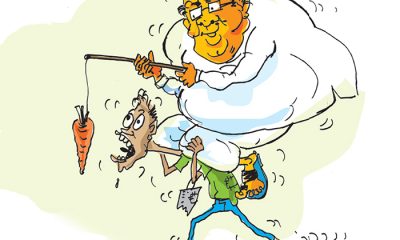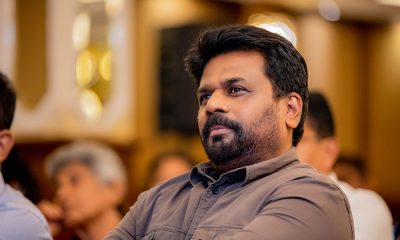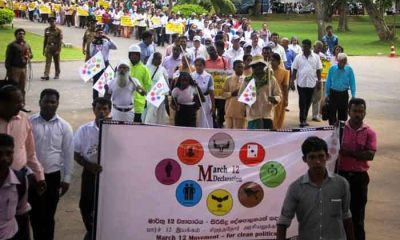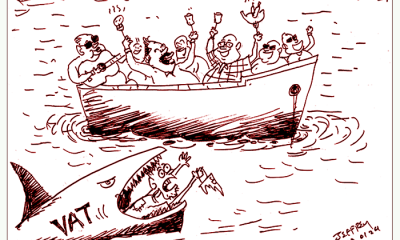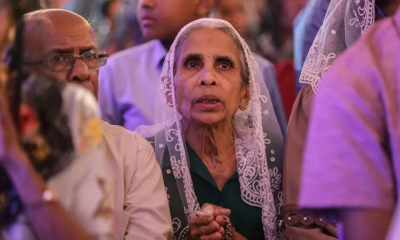Features
Channel 4 resurrects Easter Sunday, rips open can of squirming worms

by Rajan Philips
Channel 4 has resurrected Easter and divided the political waters. Like Moses leading the Israelis through the divided waters of the Red Sea, Cardinal Malcolm Ranjith is leading his faithful through the divided political waters of the country. Without taking a position on the Channe 4 documentary, the Cardinal has hit the nail on the head by calling for a “free, impartial, just, transparent and broad based investigation” into Channel 4 revelations by “an independent international investigation team”. At the same time, Cardinal Ranjith has confirmed his willingness “to forgive the perpetrators of the Easter Sunday attacks if they accept responsibility and repent,” emulating the Truth and Reconciliation experience in South Africa.
Forgiving is core to transitional justice, just as remembering and commemorating is an essential part of healing for the victims of injustice. Covering up crimes, on the other hand, is to perpetuate injustice and to reward those who wrong at the expense of those who have been wronged.
In instances of political crimes, grievously wronged. While enough is being said about the veracity, or otherwise, of the Channel 4 Despatches, the real consequence of Channel 4 goes beyond connecting the dots leading up to 2019 Easter Sunday. Quite inadvertently, Channel 4 has provided a broad wraparound encompassing all the political crimes of this century and the state’s unwillingness to solve any of them.
What has been brought into sudden relief is the whole web of crimes from the murder of Lasantha Wickrematunge to the massacres of Easter Sunday. You can extend the web before and after – to the murder of Kumar Ponnambalam literally at the turn of the millennium, to the killing of Dinesh Schaffter less than a year ago. On the former, a government lawyer actually said in court that the case file had gone missing. On the latter, the police are still trying to officially figure out how Mr. Schaffter died, even though everyone who knows about the case knows how he died. In between lies a whole web of unsolved crimes, Scot-free criminals, and well-protected masterminds. Channel 4 has ripped open a whole can of squirming worms. Closing the can seems to be finally becoming an impossible task.
Cover-up politics
Gotabaya Rajapaksa jumped the gun in rushing to his own defense with a silly statement under a sillier signature as the Seventh Executive President (who on earth will sign like this except the organic man). His still faithful loyalists came out to join him thinking that the tide had begun to turn. It has, but the other way around. Channel 4 skeptics and establishment minnows are being drowned out by calls for an international inquiry in one form or another. Even Maithripala Sirisena and Namal Rajapaksa are for it. Erstwhile (Mahinda) Rajapaksa loyalists are letting themselves off the leash and are going on a tear for Gota. There is even a new political explanation for the Easter bombings. It was not so much to win the presidential election as it was to secure the family nomination as a presidential candidate. It is turning out to be Gota vs. the Rest – of the family, that is, not necessarily the country.
In Geneva, Ambassador Himalee Arunatilaka (a career diplomat, finally displacing the guest artist that Gotabaya sent to UNHRC) is doing the thankless job of insisting that extensive and comprehensive investigations have been carried out by the government with the assistance of the Australian Federal Police, the FBI of the United States and INTERPOL. But she knows what all informed Sri Lankans and those listening to her in Geneva know. They know that nothing by way of the whole truth has come out of these investigations to conclusively indicate who knew and did what and when.
The Supreme Court ruling has become a convenient red herring for Gota apologists. The Court ruling was on a Fundamental Rights application against those in power for their dereliction of duty. It is not the last word on who conspired with whom to cause what happened on Easter Sunday. Nor does what is reported as 79 indictments so far answers the question whether there was a mastermind pulling strings behind the bombings.
President Wickremesinghe is reported to have told his cabinet that the Channel 4 documentary does not concern the government and it would be up to the individuals concerned by it to decide to respond or not. That position did not last long, so he announced another Parliamentary Select Committee hearing, and to top it up with yet a different committee headed by a former Supreme Court Judge.
The Catholic Church has rejected it. What is coming out loud and clear is that the Channel 4 revelations deserve to be investigated, with credible international presence or observation. No one is buying the establishment line, which is also the Gota line, that there has been enough investigation and inquiry already. No one believes that the Easter attacks were the result of some spontaneous eruption of Islamic Fundamentalism. The concern goes beyond Easter, and includes all the political crimes before and after.
Political Violence and Political Crimes
Sri Lanka’s web of political crimes should not be viewed in isolation from the fields of killing that Sri Lanka suffered during the JVP insurrection and the LTTE ‘war’. At the same time, it is necessary to note that there are differences between political violence of the past and the political crimes that have been multiplying even after political violence was ended. The last decades of the 20th century were engulfed in political violence. The early decades of this century are being marred by political crimes.
The JVP is now reborn and is now recognized as an agent of hope within the political system – quite a world apart from its earlier role as an agent of disruption against the system. The LTTE violence is now history, but its legacy continues in the politics over reconciliation and in the harassment of Tamils and Muslims in the North and East under cover of pseudo Archaeology. Even though political violence has ended, the culture of violence it created and the resources of violence it amassed have facilitated the emergence of political crimes and their continuation.
A characteristic of political violence, whether it was JVP or LTTE, was that it was not conducted in the interests of political families or for electoral gains of political families or organizations. I am not suggesting this characteristic is a redeeming feature of violence, or a justification for it. Only to contrast with the web of political crimes that has now become a fact of life, and which involves the interests of one or more political families. Some are more prominent at the national level; others rule the roost at the local levels without national notoriety.
While contrasting political violence and political crimes, it is also possible to see the 2019 Easter Sunday tragedies as a coming together of the two. Quite literally, the web of allegations has brought together those who were active in the political violence of the LTTE and those who were spearheading the violence of the state against the LTTE. The specific intersection of the Rajapaksa family and LTTE renegades started long before 2019 Easter Sunday and has been continuing since. The linkage between them that is now alleged by Channel 4 was quite definitively exposed by Amnesty International over what it called the “the collapse of Joseph Pararajasingham murder case.”
That was when S. Chandrakanthan (aka Plillayan) was controversially acquitted along with four others in the 2005 assassination of TNA MP Joseph Pararajasingham, who was killed while attending Christmas Mass at the Batticaloa Cathedral. The Attorney General announced that he would be dropping the charges against the suspects. Mr. Chandrakanthan has since become an MP, and is now a State Minister. He is not the only one enabled by the Rajapaksas to overcome murder conviction and enter parliament. Premalal Jayasekara from the Ratnapura District is another such beneficiary. And the two men represent not the cover up of crimes but the celebration of them by parliament itself, which was once “the supreme instrument of state power.”
What Channel 4 has unintentionally done is to disrupt the process of normalization of crimes, and the acquiescence of Sri Lankan society to get on with life while turning a blind eye to the perpetration of political crimes and their cover up. Those who rush to question the veracity of Channel 4 revelations, should also pause to reflect on the unanswered questions surrounding so many individual killings and involving the politically powerful. The debate over Channel 4 has brought to surface the moral contradictions of Sri Lankan society. And the debate has taken a new turn.
Features
An opportunity to move from promises to results

The local government elections, long delayed and much anticipated, are shaping up to be a landmark political event. These elections were originally due in 2023, but were postponed by the previous government of President Ranil Wickremesinghe. The government of the day even defied a Supreme Court ruling mandating that elections be held without delay. They may have feared a defeat would erode that government’s already weak legitimacy, with the president having assumed office through a parliamentary vote rather than a direct electoral mandate following the mass protests that forced the previous president and his government to resign. The outcome of the local government elections that are taking place at present will be especially important to the NPP government as it is being accused by its critics of non-delivery of election promises.
Examples cited are failure to bring opposition leaders accused of large scale corruption and impunity to book, failure to bring a halt to corruption in government departments where corruption is known to be deep rooted, failure to find the culprits behind the Easter bombing and failure to repeal draconian laws such as the Prevention of Terrorism Act. In the former war zones of the north and east, there is also a feeling that the government is dragging its feet on resolving the problem of missing persons, those imprisoned without trial for long periods and return of land taken over by the military. But more recently, a new issue has entered the scene, with the government stating that a total of nearly 6000 acres of land in the northern province will be declared as state land if no claims regarding private ownership are received within three months.
The declaration on land to be taken over in three months is seen as an unsympathetic action by the government with an unrealistic time frame when the land in question has been held for over 30 years under military occupation and to which people had no access. Further the unclaimed land to be designated as “state land” raises questions about the motive of the circular. It has undermined the government’s election campaign in the North and East. High-level visits by the President, Prime Minister, and cabinet ministers to these regions during a local government campaign were unprecedented. This outreach has signalled both political intent and strategic calculation as a win here would confirm the government’s cross-ethnic appeal by offering a credible vision of inclusive development and reconciliation. It also aims to show the international community that Sri Lanka’s unity is not merely imposed from above but affirmed democratically from below.
Economic Incentives
In the North and East, the government faces resistance from Tamil nationalist parties. Many of these parties have taken a hardline position, urging voters not to support the ruling coalition under any circumstances. In some cases, they have gone so far as to encourage tactical voting for rival Tamil parties to block any ruling party gains. These parties argue that the government has failed to deliver on key issues, such as justice for missing persons, return of military-occupied land, release of long-term Tamil prisoners, and protection against Buddhist encroachment on historically Tamil and Muslim lands. They make the point that, while economic development is important, it cannot substitute for genuine political autonomy and self-determination. The failure of the government to resolve a land issue in the north, where a Buddhist temple has been put up on private land has been highlighted as reflecting the government’s deference to majority ethnic sentiment.
The problem for the Tamil political parties is that these same parties are themselves fractured, divided by personal rivalries and an inability to form a united front. They continue to base their appeal on Tamil nationalism, without offering concrete proposals for governance or development. This lack of unity and positive agenda may open the door for the ruling party to present itself as a credible alternative, particularly to younger and economically disenfranchised voters. Generational shifts are also at play. A younger electorate, less interested in the narratives of the past, may be more open to evaluating candidates based on performance, transparency, and opportunity—criteria that favour the ruling party’s approach. Its mayoral candidate for Jaffna is a highly regarded and young university academic with a planning background who has presented a five year plan for the development of Jaffna.
There is also a pragmatic calculation that voters may make, that electing ruling party candidates to local councils could result in greater access to state funds and faster infrastructure development. President Dissanayake has already stated that government support for local bodies will depend on their transparency and efficiency, an implicit suggestion that opposition-led councils may face greater scrutiny and funding delays. The president’s remarks that the government will find it more difficult to pass funds to local government authorities that are under opposition control has been heavily criticized by opposition parties as an unfair election ploy. But it would also cause voters to think twice before voting for the opposition.
Broader Vision
The government’s Marxist-oriented political ideology would tend to see reconciliation in terms of structural equity and economic justice. It will also not be focused on ethno-religious identity which is to be seen in its advocacy for a unified state where all citizens are treated equally. If the government wins in the North and East, it will strengthen its case that its approach to reconciliation grounded in equity rather than ethnicity has received a democratic endorsement. But this will not negate the need to address issues like land restitution and transitional justice issues of dealing with the past violations of human rights and truth-seeking, accountability, and reparations in regard to them. A victory would allow the government to act with greater confidence on these fronts, including possibly holding the long-postponed provincial council elections.
As the government is facing international pressure especially from India but also from the Western countries to hold the long postponed provincial council elections, a government victory at the local government elections may speed up the provincial council elections. The provincial councils were once seen as the pathway to greater autonomy; their restoration could help assuage Tamil concerns, especially if paired with initiating a broader dialogue on power-sharing mechanisms that do not rely solely on the 13th Amendment framework. The government will wish to capitalize on the winning momentum of the present. Past governments have either lacked the will, the legitimacy, or the coordination across government tiers to push through meaningful change.
Obtaining the good will of the international community, especially those countries with which Sri Lanka does a lot of economic trade and obtains aid, India and the EU being prominent amongst these, could make holding the provincial council elections without further delay a political imperative. If the government is successful at those elections as well, it will have control of all three tiers of government which would give it an unprecedented opportunity to use its 2/3 majority in parliament to change the laws and constitution to remake the country and deliver the system change that the people elected it to bring about. A strong performance will reaffirm the government’s mandate and enable it to move from promises to results, which it will need to do soon as mandates need to be worked at to be long lasting.
by Jehan Perera
Features
From Tank 590 to Tech Hub: Reunited Vietnam’s 50-Year Journey

 The fall of Saigon (now Ho Chi Minh City – HCM) on 30 April 1975 marked the end of Vietnam’s decades-long struggle for liberation—first against French colonialism, then U.S. imperialism. Ho Chi Minh’s Viet Minh, formed in 1941, fought Japanese occupiers and later defeated France at Dien Bien Phu (1954). The Geneva Accords temporarily split Vietnam, with U.S.-backed South Vietnam blocking reunification elections and reigniting conflict.
The fall of Saigon (now Ho Chi Minh City – HCM) on 30 April 1975 marked the end of Vietnam’s decades-long struggle for liberation—first against French colonialism, then U.S. imperialism. Ho Chi Minh’s Viet Minh, formed in 1941, fought Japanese occupiers and later defeated France at Dien Bien Phu (1954). The Geneva Accords temporarily split Vietnam, with U.S.-backed South Vietnam blocking reunification elections and reigniting conflict.
The National Liberation Front (NLF) led resistance in the South, using guerrilla tactics and civilian support to counter superior U.S. firepower. North Vietnam sustained the fight via the Ho Chi Minh Trail, despite heavy U.S. bombing. The costly 1968 Tet Offensive exposed U.S. vulnerabilities and shifted public opinion.
Of even more import, the Vietnam meat-grinder drained the U.S. military machine of weapons, ammunition and morale. By 1973, relentless resistance forced U.S. withdrawal. In March 1975, the Vietnamese People’s Army started operations in support of the NLF. The U.S.-backed forces collapsed, and by 30 April the Vietnamese forces forced their way into Saigon.
At 11 am, Soviet-made T-54 tank no. 843 of company commander Bui Quang Than rammed into a gatepost of the presidential palace (now Reunification Palace). The company political commissar, Vu Dang Toan, following close behind in his Chinese-made T-59 tank, no. 390, crashed through the gate and up to the palace. It seems fitting that the tanks which made this historic entry came from Vietnam’s principal backers.
Bui Quang Than bounded from his tank and raced onto the palace rooftop to hoist the NLF flag. Meanwhile, Vu Dang Toan escorted the last president of the U.S.-backed regime, Duong Van Minh, to a radio station to announce the surrender of his forces. This surrender meant the liberation not only of Saigon but also of the entire South, the reunification of the country, and a triumph of perseverance—a united, independent nation free from foreign domination after a 10,000-day war.
Celebrations
On 30 April 2025, Vietnam celebrated the 50th anniversary of the Liberation of the South and National Reunification. HCM sprouted hundreds of thousands of national flags and red hammer-and-sickle banners, complemented by hoardings embellished with reminders of the occasion – most of them featuring tank 590 crashing the gate.
Thousands of people camped on the streets from the morning of 29 April, hoping to secure good spots to watch the parade. Enthusiasm, especially of young people, expressed itself by the wide use of national flag t-shirts, ao dais (traditional long shirts over trousers), conical hats, and facial stickers. This passion may reflect increasing prosperity in this once impoverished land.
The end of the war found Vietnam one of the poorest countries in the world, with a low per capita income and widespread poverty. Its economy struggled due to a combination of factors, including wartime devastation, a lack of foreign investment and heavy reliance on subsistence agriculture, particularly rice farming, which limited its potential for growth. Western sanctions meant Vietnam relied heavily on the Soviet Union and its socialist allies for foreign trade and assistance.
The Vietnamese government launched Five-Year Plans in agriculture and industry to recover from the war and build a socialist nation. While encouraging family and collective economies, it restrained the capitalist economy. Despite these efforts, the economy remained underdeveloped, dominated by small-scale production, low labour productivity, and a lack of modern technology. Inflexible central planning, inept bureaucratic processes and corruption within the system led to inefficiencies, chronic shortages of goods, and limited economic growth. As a result, Vietnam’s economy faced stagnation and severe hyperinflation.
These mounting challenges prompted the Communist Party of Vietnam to introduce Đổi Mới (Renovation) reforms in 1986. These aimed to transition from a centrally planned economy to a “socialist-oriented market economy” to address inefficiencies and stimulate growth, encouraging private ownership, economic deregulation, and foreign investment.
Transformation
Đổi Mới marked a historic turning point, unleashing rapid growth in agricultural output, industrial expansion, and foreign direct investment. Early reforms shifted agriculture from collective to household-based production, encouraged private enterprise, and attracted foreign investment. In the 2000s, Vietnam became a top exporter of textiles, electronics, and rice, shifting towards high-tech manufacturing (inviting Samsung and Intel factories). By the 2020s, it emerged as a global manufacturing hub, the future focus including the digital economy, green energy, and artificial intelligence.
In less than four decades, Vietnam transformed from a poor, agrarian nation into one of Asia’s fastest-growing economies, though structural reforms are still needed for sustainable development. Growth has remained steady, at 5-8% per year.
Vietnam’s reforms lifted millions out of poverty, created a dynamic export-driven economy, and improved education, healthcare, and infrastructure. This has manifested itself in reducing extreme poverty from 70% to 1%, increasing literacy to 96%, life expectancy from 63 to 74 years, and rural electrification from less than 50% to 99.9%. Industrialisation drove urbanisation, which doubled from 20% in 1986 to 40% now.
This change displayed itself during the celebrations in HCM, amid skyscrapers, highways and the underground metro system. Everybody dressed well, and smartphones could be seen everywhere – penetration has reached three-fourths of the population. Thousands turned out on motorbikes and scooters (including indigenous electric scooters) – two-wheeler ownership is over 70%, the highest rate per capita in ASEAN. Traffic jams of mostly new cars emphasised the growth of the middle class.
At the same time, street food vendors and makeshift pavement bistro owners joined sellers of patriotic hats, flags and other paraphernalia to make a killing from the revellers. This reflects the continuance of the informal sector– currently representing 30% of the economy.
The Vietnamese government channelled tax income from booming sectors into underdeveloped regions, investing in rural infrastructure and social welfare to balance growth and mitigate urban-rural inequality during rapid economic expansion. Nevertheless, this economic transformation came with unequal benefits, exacerbating income inequality and persistent gender gaps in wages and opportunities. Sustaining growth requires tackling corruption, upgrading workforce skills, and balancing development with inequality.
NLF flag

Tank 390 courtesy Bao Hai Duong
The parade itself, meticulously carried out (having been rehearsed over three days), featured cultural pageants and military displays and drew admiration. Of special note, the inclusion of foreign military contingents from China, Laos, and Cambodia for the first time signalled greater regional solidarity, acknowledging their historical support while maintaining a balanced foreign policy approach.
Veteran, war-era foreign journalists noted another interesting fact: the re-emergence of the NLF flag. Comprising red and blue stripes with a central red star, this flag had never been prominent at the ten-year anniversary celebrations. The journalists questioned its sudden reappearance. It may be to give strength to the idea of the victory being one of the South itself, part of a drive to increase unity between North and South.
Before reunification in 1975, North and South Vietnam embodied starkly contrasting economic and social models. The North operated under a centrally planned socialist system, with collectivised farms and state-run industries. It emphasised egalitarianism, mass education, and universal healthcare while actively preserving traditional Vietnamese culture. The South, by contrast, maintained a market-oriented economy heavily reliant on agricultural exports (rice and rubber) and foreign aid. A wealthy elite dominated politics and commerce, while Western—particularly American—cultural influence grew pervasive during the war years.
Following reunification under the Socialist Republic of Vietnam (1976), the government moved swiftly to integrate the two regions. In 1978, it introduced a unified national currency (the đồng, VND), merging the North’s and South’s financial systems into a single, state-controlled framework. The unification of monetary policy symbolised the broader ideological project: to erase colonial and capitalist legacies.
Unity and solidarity
However, the economic disparities and cultural divides between regions persist, though less pronounced than before. The South, particularly HCM, remains Vietnam’s economic powerhouse, with a stronger private sector and international trade connections. The North, including Hanoi, has a more government-driven economy. Southerners tend to have a more entrepreneurial mindset, while Northerners are often seen as more traditional and rule-bound. Conversely, individuals from the North occupy more key government positions.
Studies suggest that people in the South exhibit lower trust in the government compared to those in the North. HCM tends to have stronger support for Western countries like the United States, while Hanoi has historically maintained closer ties with China. People in HCM tend to use the old “Saigon” city name.
Consequently, the 50th anniversary celebrations saw a focus on reconciliation and unity, reflecting a shift in perspective towards peace and friendship, as well as accompanying patriotism with international solidarity.
The exuberant crowds, modern infrastructure, and thriving consumer economy showcased the transformative impact of Đổi Mới—yet lingering regional disparities, informal labour challenges, and unequal gains remind the nation that sustained progress demands inclusive reforms. The symbolic return of the NLF flag and the emphasis on unity underscored a nuanced reconciliation between North and South, honouring shared struggle while navigating enduring differences.
As Vietnam strides forward as a rising Asian economy, it balances its socialist legacy with global ambition, forging a path where prosperity and patriotism converge. The anniversary was not just a celebration of the past but a reflection on the complexities of Vietnam’s ongoing evolution.
(Vinod Moonesinghe read mechanical engineering at the University of Westminster, and worked in Sri Lanka in the tea machinery and motor spares industries, as well as the railways. He later turned to journalism and writing history. He served as chair of the Board of Governors of the Ceylon German Technical Training Institute. He is a convenor of the Asia Progress Forum, which can be contacted at asiaprogressforum@gmail.com.)
By Vinod Moonesinghe
Features
Hectic season for Rohitha and Rohan and JAYASRI
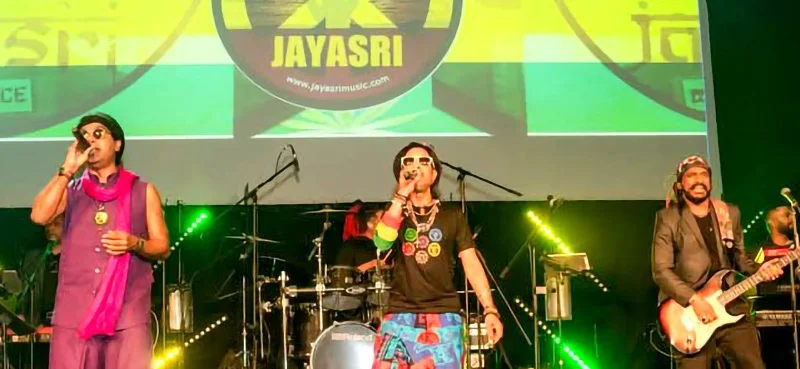
 The Sri Lanka music scene is certainly a happening place for quite a few of our artistes, based abroad, who are regularly seen in action in our part of the world. And they certainly do a great job, keeping local music lovers entertained.
The Sri Lanka music scene is certainly a happening place for quite a few of our artistes, based abroad, who are regularly seen in action in our part of the world. And they certainly do a great job, keeping local music lovers entertained.
Rohitha and Rohan, the JAYASRI twins, who are based in Vienna, Austria, are in town, doing the needful, and the twosome has turned out to be crowd-pullers.
Says Rohitha: Our season here in Sri Lanka, and summer in the south hemisphere (with JAYASRI) started in October last year, with many shows around the island, and tours to Australia, Japan, Dubai, Doha, the UK, and Canada. We will be staying in the island till end of May and then back to Austria for the summer season in Europe.”
Rohitha mentioned their UK visit as very special.
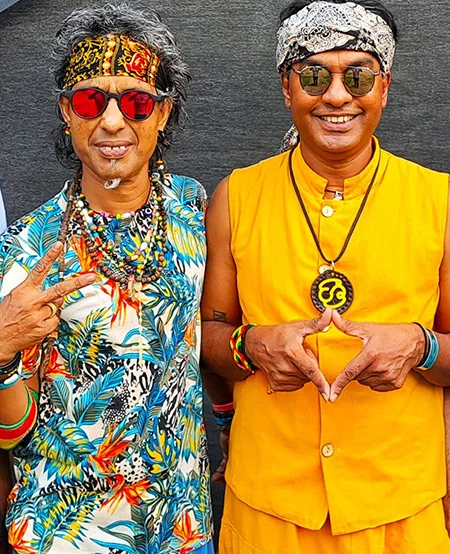
The JAYASRI twins Rohan and Rohitha
“We were there for the Dayada Charity event, organised by The Sri Lankan Kidney Foundation UK, to help kidney patients in Sri Lanka, along with Yohani, and the band Flashback. It was a ‘sold out’ concert in Leicester.
“When we got back to Sri Lanka, we joined the SL Kidney Foundation to handover the financial and medical help to the Base Hospital Girandurukotte.
“It was, indeed, a great feeling to be a part of this very worthy cause.”
Rohitha and Rohan also did a trip to Canada to join JAYASRI, with the group Marians, for performances in Toronto and Vancouver. Both concerts were ‘sold out’ events.
They were in the Maldives, too, last Saturday (03).

Alpha Blondy:
In action, in
Colombo, on
19th July!
JAYASRI, the full band tour to Lanka, is scheduled to take place later this year, with Rohitha adding “May be ‘Another legendary Rock meets Reggae Concert’….”
The band’s summer schedule also includes dates in Dubai and Europe, in September to Australia and New Zealand, and in October to South Korea and Japan.
Rohitha also enthusiastically referred to reggae legend Alpha Blondy, who is scheduled to perform in Sri Lanka on 19th July at the Air Force grounds in Colombo.
“We opened for this reggae legend at the Austria Reggae Mountain Festival, in Austria. His performance was out of this world and Sri Lankan reggae fans should not miss his show in Colombo.”
Alpha Blondy is among the world’s most popular reggae artistes, with a reggae beat that has a distinctive African cast.
Calling himself an African Rasta, Blondy creates Jah-centred anthems promoting morality, love, peace, and social consciousness.
With a range that moves from sensitivity to rage over injustice, much of Blondy’s music empathises with the impoverished and those on society’s fringe.
-

 Sports6 days ago
Sports6 days agoOTRFU Beach Tag Rugby Carnival on 24th May at Port City Colombo
-

 News5 days ago
News5 days agoRanil’s Chief Security Officer transferred to KKS
-

 Opinion3 days ago
Opinion3 days agoRemembering Dr. Samuel Mathew: A Heart that Healed Countless Lives
-

 Features6 days ago
Features6 days agoThe Broken Promise of the Lankan Cinema: Asoka & Swarna’s Thrilling-Melodrama – Part IV
-

 Features7 days ago
Features7 days agoTrump tariffs and their effect on world trade and economy with particular
-

 News6 days ago
News6 days agoRadisson Blu Hotel, Galadari Colombo appoints Marko Janssen as General Manager
-

 Business5 days ago
Business5 days agoCCPI in April 2025 signals a further easing of deflationary conditions
-

 Features6 days ago
Features6 days agoA piece of home at Sri Lankan Musical Night in Dubai



